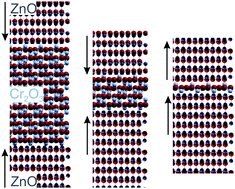Using ZnO–Cr2O3–ZnO heterostructures to characterize polarization penetration depth through non-polar films
Abstract
The ability to affect the surface properties of non-polar Cr2O3 films through polar ZnO(0001) and (000![[1 with combining macron]](https://www.rsc.org/images/entities/char_0031_0304.gif) ) supports was investigated by characterizing the polarity of ZnO films grown on top of the Cr2O3 surfaces. The growth and geometric and electronic structures of the ZnO films were characterized with X-ray photoelectron spectroscopy, ultra-violet photoelectron spectroscopy, reflection high-energy electron diffraction, low-energy electron diffraction, and X-ray diffraction. The ZnO growth mode was Stranski–Krastanov, which can be attributed to the ZnO layers initially adopting a non-polar structure with a lower surface tension before transitioning to the polar bulk structure with a higher surface energy. A similar result has been reported for ZnO growth on α-Al2O3(0001), which is isostructural with Cr2O3. The polarity of the added ZnO layer was determined by examining the surface morphology following wet chemical etching with atomic force microscopy and by characterizing the surface reactivity via temperature-programmed desorption of alcohols, which strongly depends on the ZnO polarization direction. Consistent with prior work on ZnO growth on bulk Cr2O3(0001), both measurements indicate that thick Cr2O3 layers support ZnO(000
) supports was investigated by characterizing the polarity of ZnO films grown on top of the Cr2O3 surfaces. The growth and geometric and electronic structures of the ZnO films were characterized with X-ray photoelectron spectroscopy, ultra-violet photoelectron spectroscopy, reflection high-energy electron diffraction, low-energy electron diffraction, and X-ray diffraction. The ZnO growth mode was Stranski–Krastanov, which can be attributed to the ZnO layers initially adopting a non-polar structure with a lower surface tension before transitioning to the polar bulk structure with a higher surface energy. A similar result has been reported for ZnO growth on α-Al2O3(0001), which is isostructural with Cr2O3. The polarity of the added ZnO layer was determined by examining the surface morphology following wet chemical etching with atomic force microscopy and by characterizing the surface reactivity via temperature-programmed desorption of alcohols, which strongly depends on the ZnO polarization direction. Consistent with prior work on ZnO growth on bulk Cr2O3(0001), both measurements indicate that thick Cr2O3 layers support ZnO(000![[1 with combining macron]](https://www.rsc.org/images/entities/char_0031_0304.gif) ) growth regardless of the underlying ZnO substrate polarization; however, the polarization direction of ZnO films grown on Cr2O3 films less than three repeat units thick follows the direction of the underlying substrate polarization. These findings show that it is possible to manipulate the surface properties of non-polar materials with a polar substrate, but that the effect does not penetrate past just a couple of repeat units.
) growth regardless of the underlying ZnO substrate polarization; however, the polarization direction of ZnO films grown on Cr2O3 films less than three repeat units thick follows the direction of the underlying substrate polarization. These findings show that it is possible to manipulate the surface properties of non-polar materials with a polar substrate, but that the effect does not penetrate past just a couple of repeat units.



 Please wait while we load your content...
Please wait while we load your content...